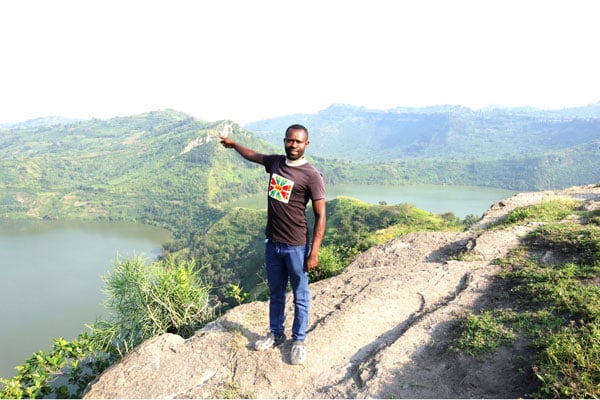Prime
A deep dive into the enchanting twin lakes of Rubiriizi District

Godfrey Nuwagaba, a guide, explains the mythical powers of the twin lakes in Rubiriizi. PHOTOS/TONY MUSHOBOROZI
What you need to know:
- Right in the tiny strip of the land that separates the two lakes, there are two stones clinging together in some sort of loving embrace.
- A popular fairytale has it that if a couple wants twins, they will pray for them here and make love.
Aboy sits atop the cusp of the cliff, unbothered by the wild height, tending to his goats that are grazing on the lakes shores, hundreds of feet deep down in the crater.
In front of him, is the breathtaking view of Lakes Kazinda and Mirambi, popularly known as the twin lakes of Kyambura. As tourists approach, marveling at the sight, he is unfazed. To him, the twin lakes are normal, even mundane.
From the top of the cliff, men fishing in the lakes are as small as grasshoppers. That is how deep these craters are. Yet, when you approach them from the western side, they are hidden from view by a rocky knoll, so that even from 30 metres away, you cannot see them. As you round the head of the knoll, you find yourself standing at the top of a cliff, astounded by the view and scared witless by the height.
You cannot help but shudder at the thought of an unwitting school teacher approaching with dozens of small school children in the name of teaching geography. This cliff is an absolute horror show. An adult with acrophobia- extreme fear of heights - may experience treacherous panic attacks at best if they found themselves here. To be in the safe zone, you have to stand several metres away from the cusp of the cliff. But to the boy grazing goats, this is all ordinary.
From the top of the cliff, looking eastwards, one can see farms and animals grazing and people walking in the winding footpaths, on their way from fetching water in the two lakes. How they all manage to make it to the top remains a puzzle.
The lakes look like two containers that someone filled with water to different levels. The water in the northerly lake- Katinda, is lower than the water in the southerly one -Mirambi. While they are called twin lakes, they are not at all connected. They would level up if that was the case. They just happen to occupy the same space.
Continuous volcanicity
According to the tour guides, the lakes still experience active volcanicity because every June and July, they become warm and emit sulphuric smelling gases. These gases can be smelt from afar during those months. In that same period, because of the heightened temperatures, the fish tend to flee from the deep waters looking for a cool breeze at the surface.
Unwilling to swim deeper, they all float on top of the waters. The locals come and pick as much as their containers can allow them and off they go to sell and to feed their families.
Lake Katinda and Lake Mirambi are popularly known as the twin lakes of Kyambura in Rubiriizi District. Because they are on the southern outskirts of Queen Elizabeth National Park, where most of the tourist lodges are located, they are popular with tourists who yearn for a casual community activity outside their itinerary.

Lake Katinda in Kyambura
Spiritual powers?
From the main viewing point, the northerly lake looks like a woman’s behind while the southerly one looks like a phallus pointing conveniently. For this reason, the locals call them lakes in love (enyanja ezikundeine).
Former generations even came up with a saying that goes, Nibakundana nka Katinda na Mirambi which means “they are in love like Katinda and Murambi” referring to couples that tend to stick together in love. As a result of this belief, the locals believe that if you propose to your spouse from the site, your relationship is likely to last forever.
Right in the tiny strip of land that separates the lakes, there are two stones that hold together in some sort of loving embrace. According to Godfrey Nuwagaba, the guide, popular legend has it that if you want twins, you come with your wife and pray for twins while seated on the stones.
“After the prayer session, you are required to make love right there and if the gods are pleased with you, she will conceive twins,” he says. If it sounds like a tall tale, it is because it might be.
Other lakes in the area
Surprisingly, these are not the only twin lakes in the district. There is Kyema and Kamweru a few kilometers south of these. They are also not levelled and what makes them special is that they come in different colours. One is green, while the other has a reddish hue.
The green one is said to be only 90 years old, according to Nuwagaba, as it was formed around 1930 when a nearby lake drained into a dry crater through a cracked rock. The former lake became a mere swamp after losing all its water. In total, the district has 32 such crater lakes, the most famous of them being the one that looks like the map of Africa.
The locals enjoy this incredible view every day because they fetch water from the lakes and graze their goats in the escarpments of the craters. While the water looks turbid green from afar, when you get to the shore, the water clears out.
Tilapia, albeit smaller than normal, is the common type of fish in these lakes because the twin lakes are so deep. Silver fish is also available.
Local innovation
One year ago, this was an open-to-all tourist site, according to Rachel Aheebwa, the Jewel Safaris female driver. Tourists, on their way to or from Queen Elizabeth National Park would make a short detour, to take in the spectacle before driving off again. Not anymore.
A few local young men, including Godfrey Nuwagaba who knew a thing or two about tourism, realised the opportunity here and decided to innovate. They built a temporary gate in the only road that leads to the lakes and appointed themselves special tour guides in charge of the lakes and waited for tourist vehicles to arrive. This was just last year. Around June of 2023. Today, they make a living from answering tourists’ questions.




